Viscoelastic Parameter Prediction of Multi-Layered Coarse-Grained Soil with Consideration of Interface-Layer Effect
Abstract
:1. Introduction
2. Viscoelastic Parameter Model of the Multi-Layered CGS
2.1. Structure Model of the Multi-Layered CGS
2.2. Viscoelastic Parameter Model of One-Layered CGS
2.3. Viscoelastic Parameter Model of the Interface-Layer
2.4. Viscoelastic Parameter Formulae of the Multi-Layered CGS
3. Viscoelastic Parameter Prediction of the Multi-Layered CGS
3.1. Measuring Viscoelastic Parameters of the Sand–Clay Matrix
3.2. Predicting Viscoelastic Parameters of Multi-Layered CGS
- Calculate the elastic modulus (ET, superscript T means Laplace space) of the sand–clay matrix by the elastic–viscoelastic correspondence principle as Equation (19).where s is Laplace transform parameter.
- Calculate the equivalent elastic modulus (Ks, Es) of the solid phase (pebble, sand–clay matrix) by Equations (1) and (4).
- Calculate the equivalent elastic modulus (Ko, Eo) of the one-layered CGS by Equations (6) and (7).
- Calculate the equivalent elastic modulus (Ki, Ei) of the interface-layers by Equations (10)–(12).
- Calculate the equivalent elastic modulus (E) of the multi-layered CGS by Equation (15).
- Calculate the equivalent viscoelastic parameters (J) of the multi-layered CGS by Equation (16). and elastic–viscoelastic correspondence principle, as listed in Table 4.
4. Experimental Verification
4.1. Triaxial Creep Test
4.2. Test Results and Analyses
4.2.1. Creep Curve of One-Layered CGS
4.2.2. Viscoelastic Parameter–Time Curves of Interface-Layer
4.2.3. Creep Curve of Two-Layered CGS
4.2.4. Creep Curve of Three-Layered CGS
4.2.5. Comparing the Creep Curves of Two-Layered and Three-Layered CGS
5. Conclusions
- (1)
- The interface-layer of viscoelasticity and the actual shape of large-particle inclusion were firstly considered and a new interface-layer method was proposed to predict viscoelastic parameters of multi-layered CGS based on homogenization method and elastic–viscoelastic corresponding principle. The tested creep curves of the multi-layered CGS agreed well with the predicted ones and can prove the existence of the interface-layer and verify the validity of this new method.
- (2)
- For the one-layered CGS, the creep deformation decreased as the shape factor (ρ) of pebble inclusion increased and ρ was in the range of 1–1.8.
- (3)
- The viscoelastic parameters of the interface-layer were smaller than the average values of one-layered CGS which consisted of the interface-layer.
- (4)
- For the two-layered CGS, the creep deformation decreased with the increase of the interface-layer height (h) and the suitable interface-layer height was 20–30% as much as the height of one-layered CGS.
- (5)
- For the three-layered CGS, the creep deformation decreased with the increase of the interface-layer number (N) and at least one interface-layer must be taken into account.
- (6)
- For the safety point of view, it is better to use a high degree of irregular pebble and a large difference in gradation of CGS and more layer numbers to reduce the creep deformation of multi-layered coarse-grained soil. Construction costs should be taken into account in design of pavement or embankment.
Author Contributions
Funding
Acknowledgments
Conflicts of Interest
References
- Ministry of Water Resources of the People’s Republic of China. GB/T 50145—2007. Standard for Engineering Classification of Soil; Planning Press: Beijing, China, 2008; pp. 94–96.
- Medley, E. The Engineering Characterization of Mélanges and Similar Block-In-Matrix Rocks (Bimrocks). Ph.D. Thesis, University of California, California, CA, USA, 1994. [Google Scholar]
- Wang, T.; Liu, S.; Feng, Y.; Yu, J. Compaction Characteristics and Minimum Void Ratio Prediction Model for Gap-Graded Soil-Rock Mixture. Appl. Sci. 2018, 8, 2584. [Google Scholar] [CrossRef] [Green Version]
- Guo, G.Q. Engineering Characteristics and Application of Coarse Grained Soil; The Yellow River Water Conservancy Press: Zheng Zhou, China, 1998. [Google Scholar]
- Chen, J. Study on Mechanism of Effect of Particle Packing Structure on Engineering Properties of Coarse-Grained Soil Filling High-Speed Railway Embankment. Ph.D. Thesis, Southwest Jiaotong University, Guangzhou, China, 2014. [Google Scholar]
- Ministry of Transport of the People’s Republic of China. Technical Specifications for Construction of Highway Subgrade JTG/T 3610-2019; Communications Press: Beijing, China, 2019.
- Ghalesari, A.T.; Rasouli, H. Effect of Gravel Layer on the Behavior of Piled Raft Foundations. ASCE GSP 2014, 240, 373–382. [Google Scholar] [CrossRef]
- Ghalesari, A.T.; Tabari, M.K.; Choobbasti, A.J.; EsmaeilpourShirvanib, N. Behavior of eccentrically loaded shallow foundations resting on composite soils. J. Build Eng. 2019, 23, 220–230. [Google Scholar] [CrossRef]
- Duong, T.V.; Cui, Y.J.; Tang, A.M.; Dupla, J.C.; Canou, J.; Calon, N.; Robinet, A. Investigating the mud pumping and interlayer creation phenomena in railway sub-structure. Eng. Geol. 2014, 171, 45–58. [Google Scholar] [CrossRef]
- Zhang, S.; Li, Y.; Li, J.; Liu, L. Reliability Analysis of Layered Soil Slopes Considering Different Spatial Autocorrelation Structures. Appl. Sci. 2020, 10, 4029. [Google Scholar] [CrossRef]
- Moayedi, H.; Bui, D.T.; Thi Ngo, P.T. Neural Computing Improvement Using Four Metaheuristic Optimizers in Bearing Capacity Analysis of Footings Settled on Two-Layer Soils. Appl. Sci. 2019, 9, 5264. [Google Scholar] [CrossRef] [Green Version]
- Chen, X.B. Research on the Highway Embankment Granular Soil Fillings’ Rheological Properties. Ph.D. Thesis, Central South University, Changsha, China, 2007. [Google Scholar]
- Feng, Y.; Phillion, A.B. A 3D meso-scale solidification model for metallic alloy using a volume average approach. Materialia 2019, 6, 100329. [Google Scholar] [CrossRef]
- Zheng, H.W.; Peng, X.H.; Ding, J.P.; Tian, Z.A. Micromechanical Model of Ceramic Particulate Reinforced Composites. China Ceram. 2016, 52, 39–42. (In Chinese) [Google Scholar]
- Tang, X.W. Study on Damage and Fracture Behavior of Concrete Based on Macro and Meso Mechanics. Ph.D. Thesis, Tsinghua University, Beijing, China, 2008. [Google Scholar]
- Du, X.L.; Jin, L.; Ma, G.W. Macroscopic effective mechanical properties of porous dry concrete. Cem. Concr. Res. 2013, 44, 87–96. [Google Scholar] [CrossRef]
- Chang, D.; Lai, Y.M.; Zhang, M.Y. A meso-macroscopic constitutive model of frozen saline sandy soil based on homogenization theory. Int. J. Mech. Sci. 2019, 159, 246–259. [Google Scholar] [CrossRef]
- Wang, Z.C. Study on Viscoelastic Properties of Asphalt Mixtures Based on Micromechanics. Ph.D. Thesis, Dalian Maritime University, Dalian, China, 2011. [Google Scholar]
- Wang, P.; Liu, E.L.; Zhi, B. A macro–micro viscoelastic-plastic onstitutive model for saturated frozen soil. Mech. Mater. 2020, 147, 103411. [Google Scholar] [CrossRef]
- Vallejo, L.E.; Lobo, G.S. The elastic moduli of clays with dispersed oversized particles. Eng. Geol. 2005, 78, 163–171. [Google Scholar] [CrossRef]
- Yang, H.; Zhou, Z.; Wang, X.C. Elastic modulus calculation model of a soil-rock mixture at normal or freezing temperature based on micromechanics approach. Adv. Mater. Sci. Eng. 2015, 2015, 1–10. [Google Scholar] [CrossRef] [Green Version]
- Hu, M. Numerical Method to Study the Physical and Mechanical Characteristics of Sandy Pebble Soil and the Response Caused by Shield Tunneling. Ph.D. Thesis, South China University of Technology, Guangzhou, China, 2014. [Google Scholar]
- Barbero, M.; Bonini, M.; Borri, B.M. Three-dimensional finite element simulations of compression tests on bimrock. In Proceedings of the 12th International Conference of International Association for Computer Methods and Advances in Geomechanics, Goa, India, 1–6 October 2008; pp. 31–37. [Google Scholar]
- Xu, W.J.; Yue, Z.Q.; Hu, R.L. Study on the mesostructure and mesomechanical characteristics of the soil–rock mixture using digital image processing based finite element method. Int. J. Rock. Mech. Min. 2008, 45, 749–762. [Google Scholar] [CrossRef]
- Li, X.; Liao, Q.L.; He, J.M. In-situ tests and a stochastic structural model of rock and soil aggregate in the three gorges reservoir area. Int. J. Rock. Mech. Min. 2004, 41, 702–707. [Google Scholar] [CrossRef]
- Li, C.S.; Ellyin, F.; Wharmby, A. A damage meso-mechanical approach to fatigue failure prediction of cross-ply laminate composites. Int. J. Fatigue 2002, 24, 429–435. [Google Scholar] [CrossRef]
- Rashtiyani, H.A.; Hosseini-Toudeshky, H.; Mondal, M. Analytical study of transverse cracking in cross-ply laminates under combined loading based on a new coupled micro-meso approach. Mech. Mater. 2019, 139, 103149. [Google Scholar] [CrossRef]
- Bedzra, R.; Reese, S.; Simon, J.W. Hierarchical multi-scale modelling of flax fibre/epoxy composite by means of general anisotropic viscoelastic-viscoplastic constitutive models: Part II—Mesomechanical model. Int. J. Solids Struct. 2020, 202, 299–318. [Google Scholar] [CrossRef]
- Liu, X.Y.; Liu, E.L.; Zhang, D.; Zhang, G. Study on effect of coarse-grained content on the echanical properties of frozen mixed soils. Cold Reg. Sci. Technol. 2019, 158, 237–251. [Google Scholar] [CrossRef]
- Tabari, M.K.; Ghalesari, A.T.; Choobbasti, A.J.; Afzalirad, M. Large-Scale Experimental Investigation of Strength Properties of Composite Clay. Geotech. Geol. Eng. 2019, 37, 5061–5075. [Google Scholar] [CrossRef]
- Zhang, H.Y.; Xu, W.J.; Yu, Y.Z. Triaxial testsofsoil–rock mixtures with different rock block distributions. Soils Found 2016, 56, 44–56. [Google Scholar] [CrossRef] [Green Version]
- Mohammad, A.; Parviz, M. Failure patterns of geomaterials with block-in-matrix texture: Experimental and numerical evaluation. ARAB J. Geosci. 2014, 7, 2781–2792. [Google Scholar] [CrossRef]
- Hamidi, A.; Salimi, N.; Yazdanjou, V. Shape and size effects of gravel particles on shear strength characteristics of sandy soils. Geoscience 2011, 20, 189–196. [Google Scholar]
- Kouakou, N.M.; Cuisinier, O.; Masrouri, F. Estimation of the shear strength of coarse-grained soils with fine particles. Transp. Geotech. 2020, 25, 100407. [Google Scholar] [CrossRef]
- Hou, F.; Lai, Y.M.; Liu, E.L. A creep constitutive model for frozen soils with different contents of coarse Grains. Cold Reg. Sci. Technol. 2018, 145, 119–126. [Google Scholar] [CrossRef]
- Zhang, Y.; Han, L. Foundation of Mesomechanics; Science Press: Nanjing, China, 2014. [Google Scholar]
- Kovarik, V. Distributional Concept of the Elastic-Viscoelastic Correspondence Principle. J. Appl. Mech. 1995, 62, 847. [Google Scholar] [CrossRef]
- Park, S.W.; Kim, Y.R.; Schapery, R.A. A viscoelastic continuum damage model and its application to uniaxial behavior of asphalt concrete. Mech. Mater. 1996, 24, 241–255. [Google Scholar] [CrossRef]
- Ministry of Railways of the People’s Republic of China. Code for Design on Subgrade of Railway TB10001-2005; Railway Publishing House: Beijing, China, 2005.
- Ding, Y.; Rao, Y.K.; Ni, Q. Effects of gradation and void ratio on the coefficient of permeability of coarse-grained soil. Hydrogeol. Loeng. Geo. 2019, 46, 108–116. (In Chinese) [Google Scholar]

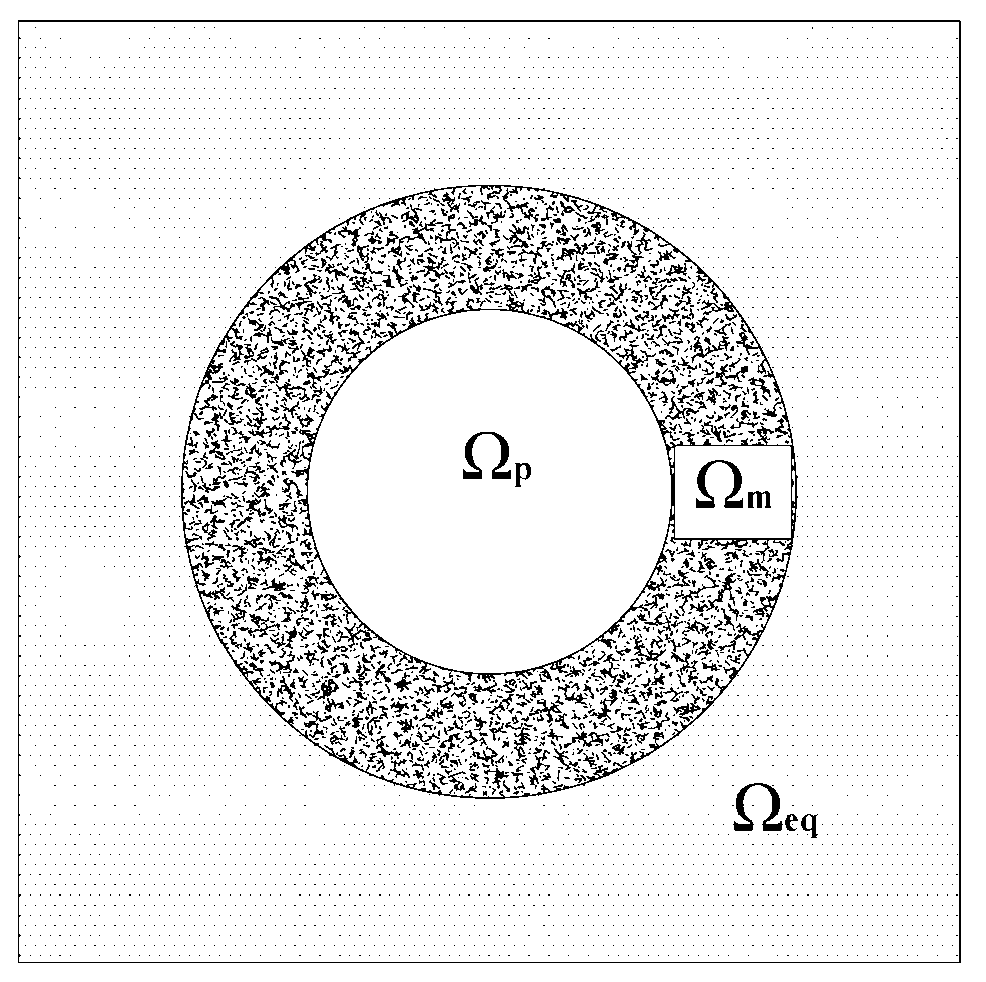
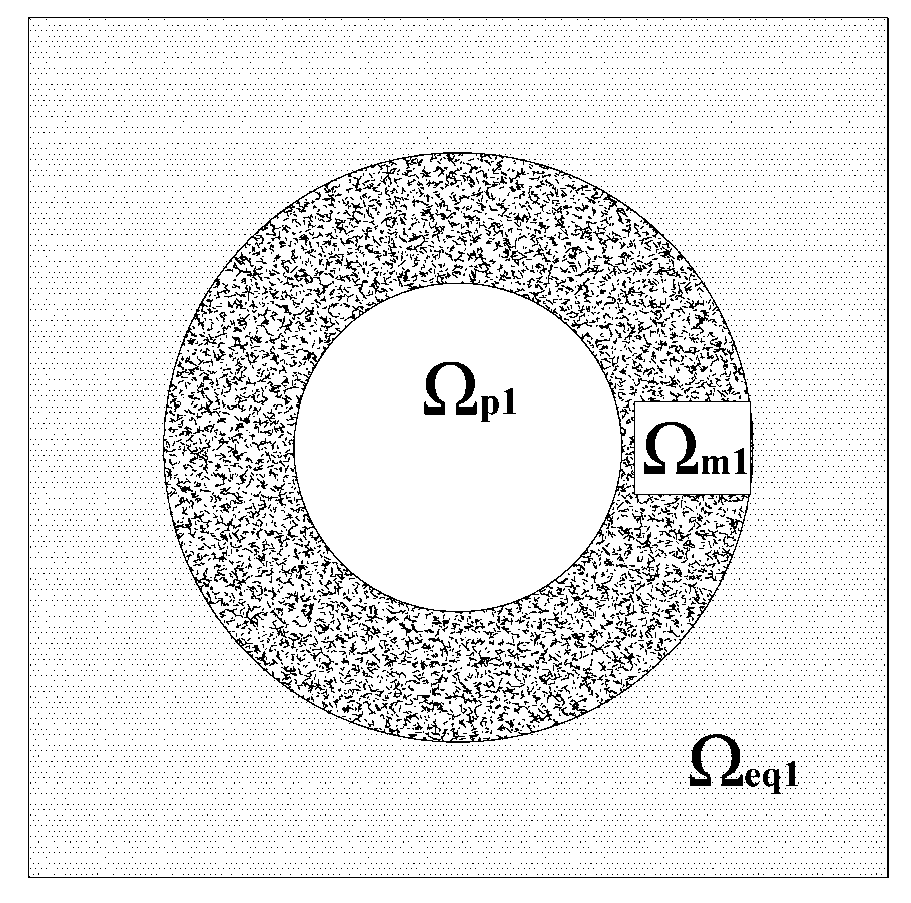


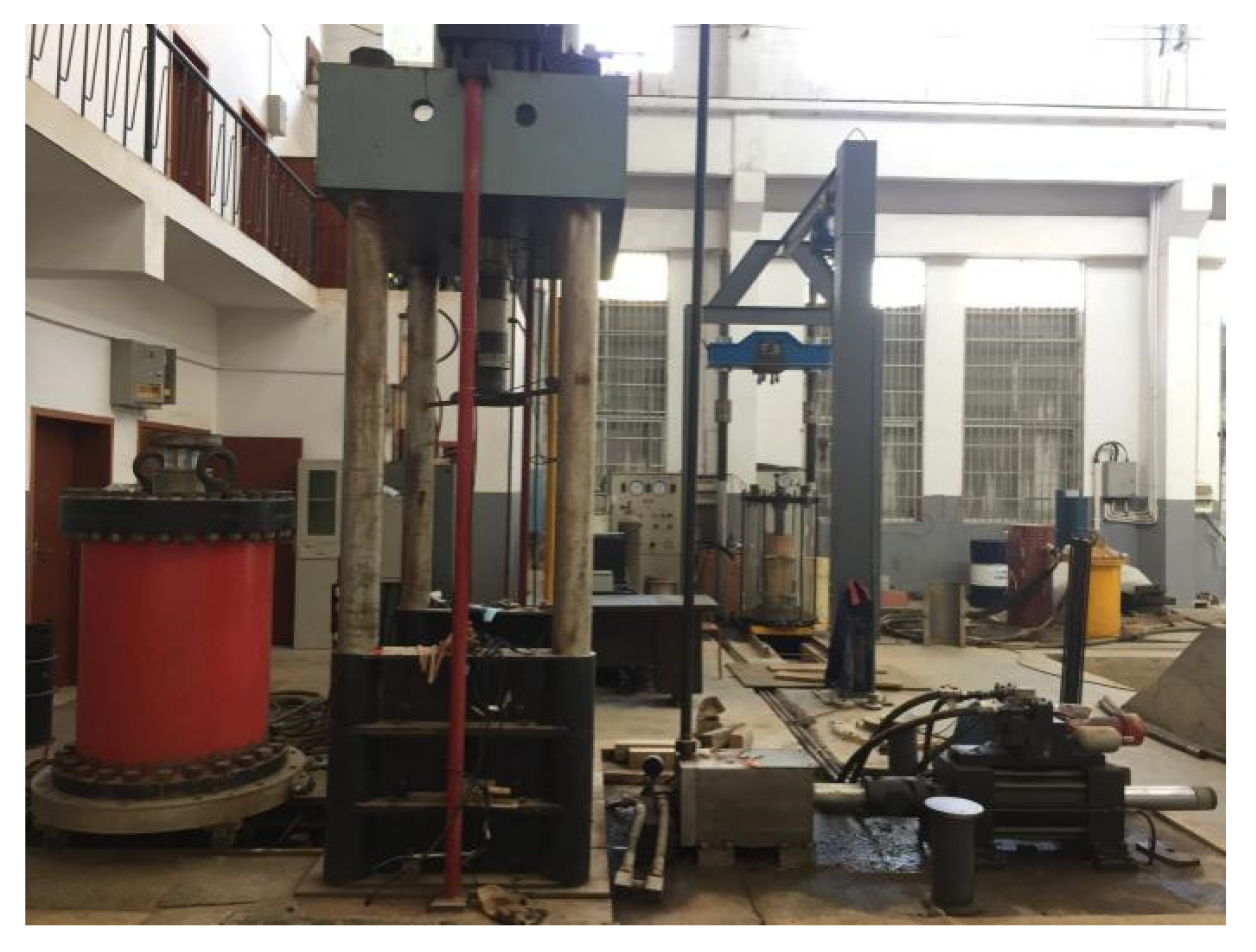
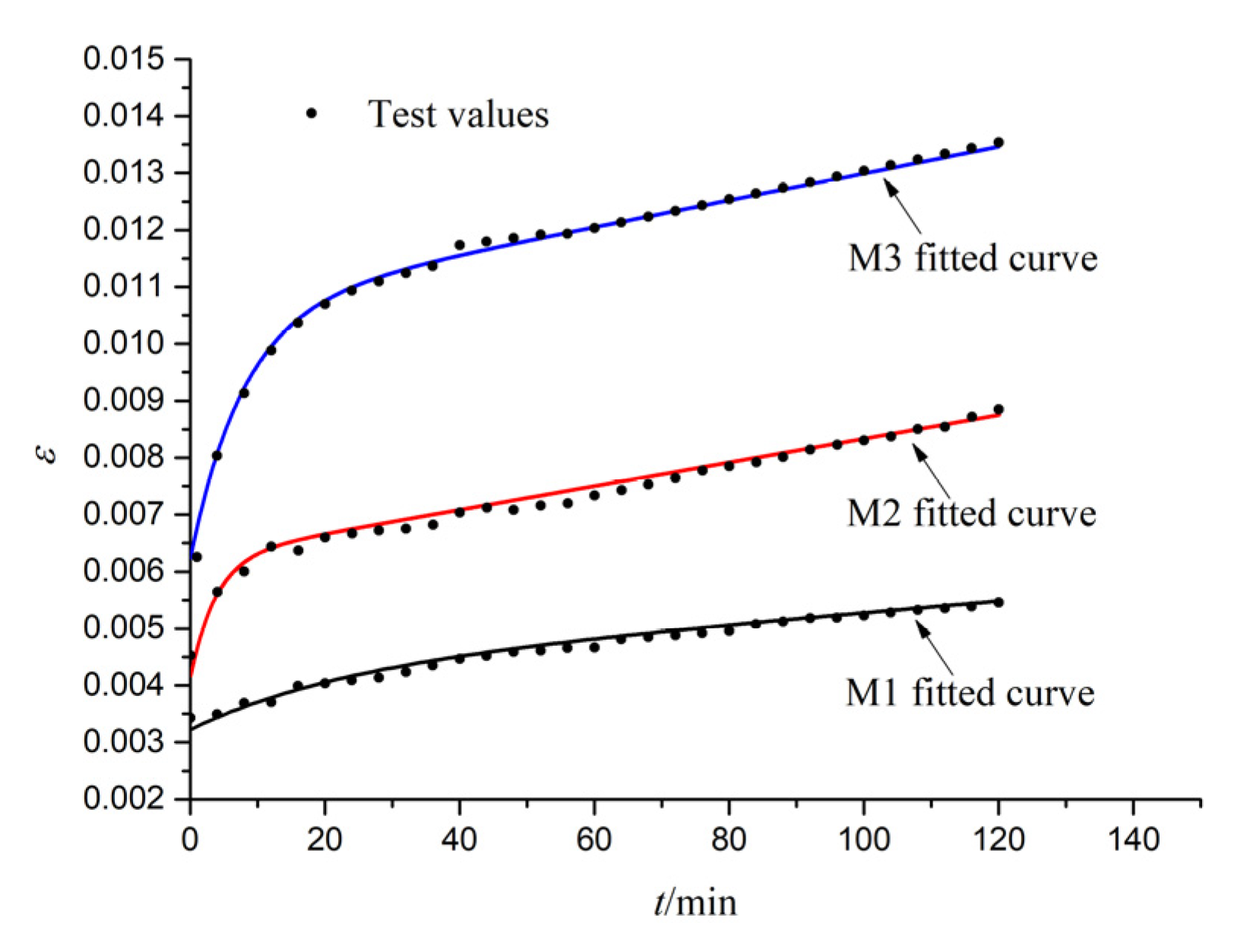


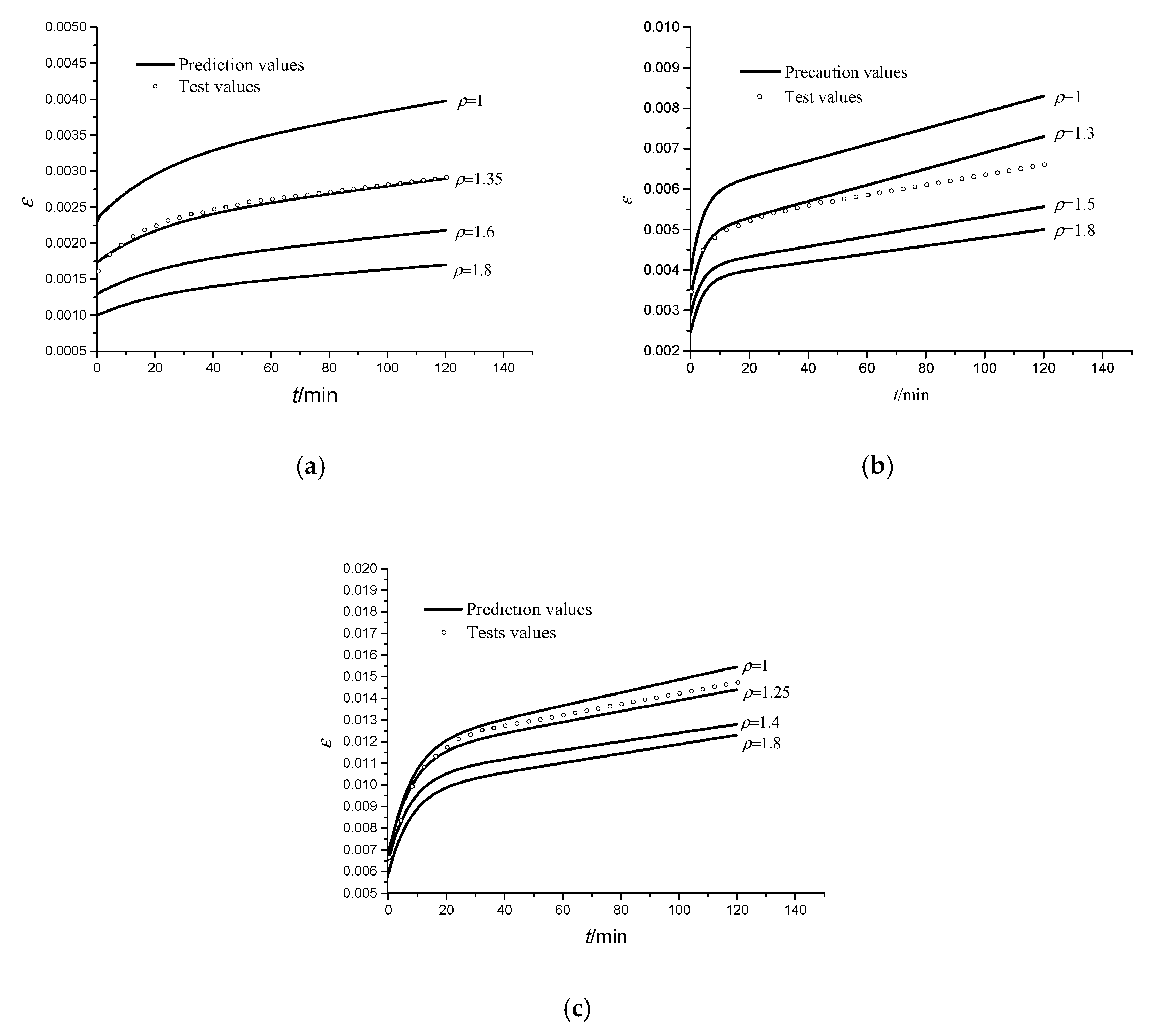
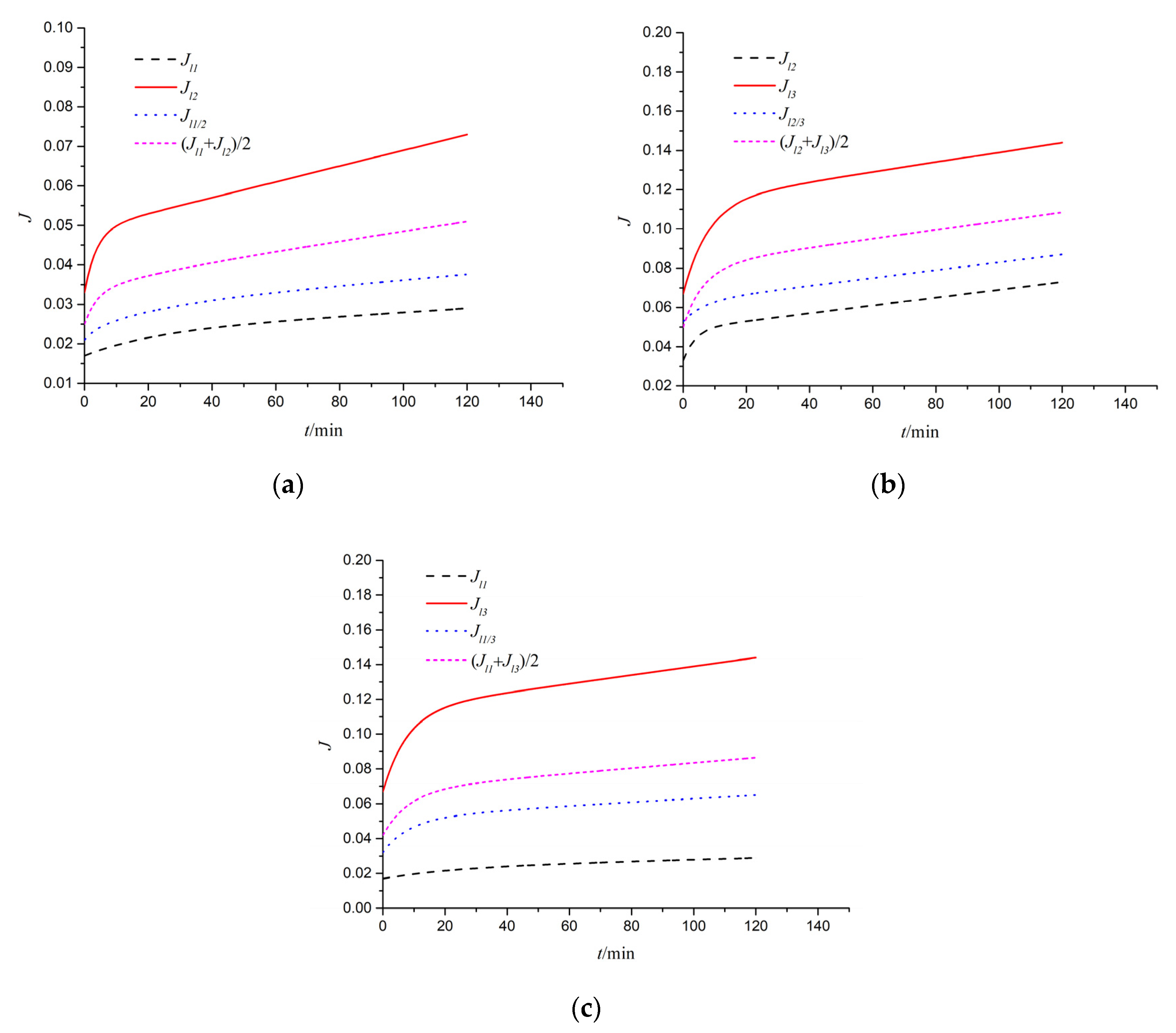
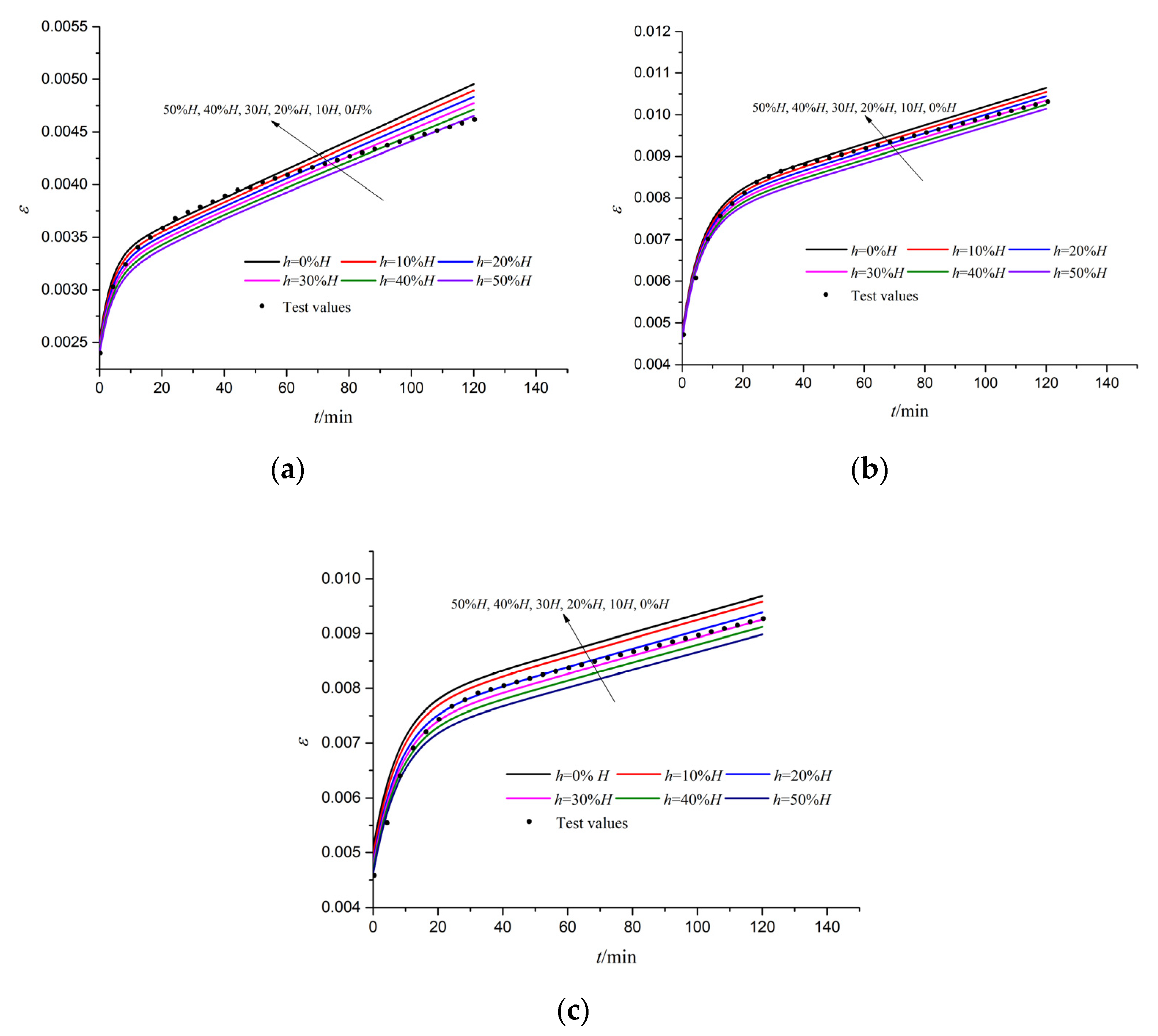


| No. | Sand | Clay |
|---|---|---|
| M1 | 1 | 0.30 |
| M2 | 1 | 0.75 |
| M3 | 1 | 1.33 |
| No. | E1/MPa | E2/MPa | η1/MPa·min | η2/MPa·min | R2 |
|---|---|---|---|---|---|
| M1 | 30.88 | 93.91 | 10041.67 | 2101.36 | 0.986 |
| M2 | 23.87 | 48.19 | 4805.48 | 182.57 | 0.991 |
| M3 | 16.02 | 22.76 | 4243.88 | 179.89 | 0.990 |
| No. | Mass Ratio of Pebble to Sand–Clay Martix | Volume Fraction of Pebble (p0) | Volume Fraction of Sand–Clay Martix (p3) |
|---|---|---|---|
| L1 | 1:1.30 | 38.9% | 41.1% |
| L2 | 1:1.75 | 26.6% | 53.4% |
| L3 | 1:2.33 | 15.7% | 64.3% |
| Layer Combination | E1/MPa | E2/MPa | η1/MPa·min | η2/MPa·min | |
|---|---|---|---|---|---|
| One-layered CGS (Jo) | L1 | 58.82 | 166.67 | 19999.97 | 3703.70 |
| L2 | 30.30 | 62.50 | 5000.05 | 236.71 | |
| L3 | 14.93 | 21.27 | 3999.91 | 167.53 | |
| Interface Layer (Ji) | L1/L2 | 46.24 | 149.21 | 12774.95 | 2176.75 |
| L2/L3 | 18.89 | 19.14 | 4999.13 | 656.87 | |
| L1/L3 | 43.36 | 20.60 | 4368.95 | 87.73 | |
| Two-layered CGS | L1 + L1/L2 + L2 | 39.30 | 104.07 | 7465.34 | 284.53 |
| L2 + L2/L3 + L3 | 19.82 | 32.54 | 4401.50 | 218.38 | |
| L1 + L1/L3 + L3 | 23.67 | 38.83 | 6412.82 | 333.94 | |
| Three-layered CGS | L1+ L1/L2 + L2 + L2/L3 + L3 | 26.41 | 48.72 | 5755.77 | 324.54 |
Publisher’s Note: MDPI stays neutral with regard to jurisdictional claims in published maps and institutional affiliations. |
© 2020 by the authors. Licensee MDPI, Basel, Switzerland. This article is an open access article distributed under the terms and conditions of the Creative Commons Attribution (CC BY) license (http://creativecommons.org/licenses/by/4.0/).
Share and Cite
Zhang, J.; Rao, Q.; Yi, W. Viscoelastic Parameter Prediction of Multi-Layered Coarse-Grained Soil with Consideration of Interface-Layer Effect. Appl. Sci. 2020, 10, 8879. https://doi.org/10.3390/app10248879
Zhang J, Rao Q, Yi W. Viscoelastic Parameter Prediction of Multi-Layered Coarse-Grained Soil with Consideration of Interface-Layer Effect. Applied Sciences. 2020; 10(24):8879. https://doi.org/10.3390/app10248879
Chicago/Turabian StyleZhang, Jie, Qiuhua Rao, and Wei Yi. 2020. "Viscoelastic Parameter Prediction of Multi-Layered Coarse-Grained Soil with Consideration of Interface-Layer Effect" Applied Sciences 10, no. 24: 8879. https://doi.org/10.3390/app10248879




